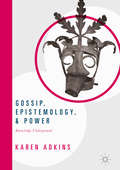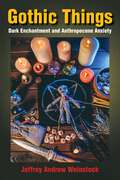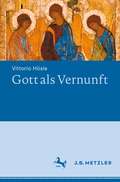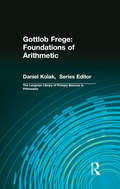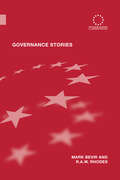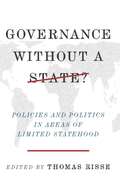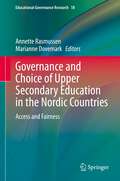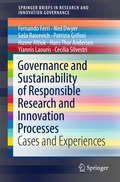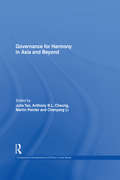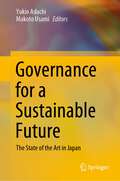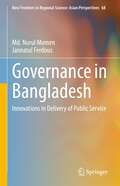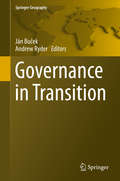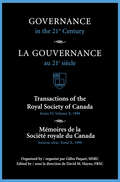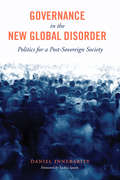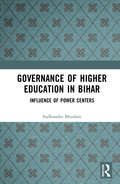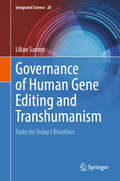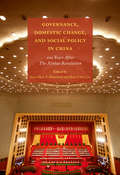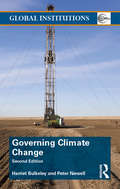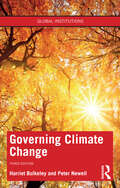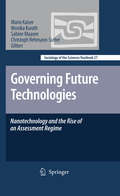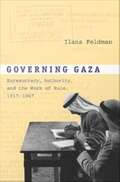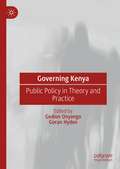- Table View
- List View
Gossip, Epistemology, and Power
by Karen AdkinsThis book explains how gossip contributes to knowledge. Karen Adkins marshals scholarship and case studies spanning centuries and disciplines to show that although gossip is a constant activity in human history, it has rarely been studied as a source of knowledge. People gossip for many reasons, but most often out of desire to make sense of the world while lacking access to better options for obtaining knowledge. This volume explores how, when our access to knowledge is blocked, gossip becomes a viable path to knowledge attainment, one that involves the asking of questions, the exchange of ideas, and the challenging of preconceived notions.
Gothic Things: Dark Enchantment and Anthropocene Anxiety
by Jeffrey Andrew WeinstockSHORTLISTED, THE ALLAN LLOYD SMITH PRIZE FOR BEST MONOGRAPHOffering an innovative approach to the Gothic, Gothic Things: Dark Enchantment and Anthropocene Anxiety breaks ground with a new materialist analysis of the genre, highlighting the ways that, since its origins in the eighteenth century, the Gothic has been intensely focused on “ominous matter” and “thing power.” In chapters attending to gothic bodies, spaces, books, and other objects, Gothic Things argues that the Gothic has always been about what happens when objects assume mysterious animacy or potency and when human beings are reduced to the status of just one thing among many—more powerful—others.In exploring how the Gothic insistently decenters the human, Jeffrey Andrew Weinstock reveals human beings to be enmeshed in networks of human and nonhuman forces mostly outside of their control. Gothic Things thus resituates the Gothic as the uncanny doppelgänger of twenty-first-century critical and cultural theory, lurking just beneath the surface (and sometimes explicitly surfacing) as it haunts considerations of how human beings interact with objects and their environment. In these pages the Gothic offers a dark reflection of the contemporary “nonhuman turn,” expressing a twenty-first-century structure of feeling undergirded by anxiety over the fate of the human: spectrality, monstrosity, and apocalypse.Substituting horror for hope, the Gothic, Weinstock explains, has been a philosophical meditation on human relations to the nonhuman since its inception, raising significant questions about how we can counter anthropocentric thought in our quest to live more harmoniously with the world around us.
Gott als Vernunft
by Vittorio HösleGott als Vernunft bietet einen Überblick über zentrale religionsphilosophische Fragestellungen auf der Grundlage des objektiven Idealismus. Gott erscheint in dieser Perspektive nicht als externe Autorität, die sich durch Willkürakte und Wunder offenbart, sondern als der Kern aller Vernunftansprüche, die weder naturalistisch noch konstruktivistisch reduziert werden können. In facettenreichen Texten werden einerseits direkt religionsphilosophische Themen wie der Gnadenbegriff, die Trinitätslehre, das Theodizeeproblem, das Problem der richtigen Bibeldeutung oder die Natur interreligiösen Dialoge von der Warte einer Vernunftreligion aus abgehandelt, andererseits die Konsequenzen einer religiösen Deutung der Wirklichkeit für das Teleologie-, das Freiheits-, das Leib-Seele-Problem, den Geistbegriff und das historische Auftreten des Atheismus untersucht.
Gottlob Frege: (Longman Library of Primary Sources in Philosophy)
by Gottlob FregePart of theLongman Library of Primary Sources in Philosophy, this edition of Frege's Foundations of Arithmetic is framed by a pedagogical structure designed to make this important work of philosophy more accessible and meaningful for undergraduates.
Governance Stories (Routledge Advances in European Politics #Vol. 34)
by Mark Bevir Rod RhodesAn incisive examination of Britain today, which breaks from traditional studies, and takes a new approach to account for massive changes in the make-up of the nation. Over the last twenty years Britain has changed from being governed as a unitary state to a country ruled by the interplay of various forces: central government, the market, public-private partnerships, new local government structures (eg. the new Mayoral system), greater regional autonomy as well as the EU and transnational businesses and organizations. In their earlier book Interpreting British Governance, Bevir and Rhodes examined changes in British government by setting out an interpretative approach to British political science, which focussed on an aggregate analysis of British political traditions. This new study builds on this work to: provide a theoretical defence of situated agency located in the historical context of British political science compare their approach to British political science with others including, post-structural and institutional analysis present a general account of governance as the context for ethnographic analyses of governance in action deliver studies of the consumers of public services, the National Health Service, government departments and policy networks. This book will be of great interest to advanced students and researchers of political theory, public policy, British politics and British history.
Governance Without a State? Policies and Politics in Areas of Limited Statehood
by Thomas RisseGovernance discourse in development agencies and the social sciences remains centered on an "ideal type" of modern statehood one that exhibits full internal and external sovereignty and a legitimate monopoly on the use of force. Yet modern statehood remains an anomaly both historically and in the contemporary international system while the condition of "limited statehood " wherein countries lack the capacity to implement central decisions and monopolize force is the norm. Limited statehood argue the authors in this provocative collection is in fact a fundamental form of governance immune to the forces of economic and political modernization ushered in by globalization. Challenging common assumptions about sovereign states and the evolution of modern statehood particularly the dominant paradigms supported by international relations theorists development agencies and international organizations this volume explores strategies for effective and legitimate governance within a framework of weak and ineffective state institutions. Approaching the problem from the perspective of political science history and law contributors explore the factors that contribute to successful governance under conditions of limited statehood such as the involvement of nonstate actors and non-hierarchical modes of political influence. Empirical chapters analyze among other issues security governance by nonstate actors the contribution of public-private partnerships to promote the United Nations Millennium Goals the role of business in environmental governance and the problems of Western state-building efforts. Recognizing these forms of governance as themselves legitimate this collection unravels the complexities of a system that the developed world must negotiate in the coming century.
Governance Without a State?: Policies and Politics in Areas of Limited Statehood (The\art Of The State Ser. #8)
by Ed. Thomas RisseGovernance discourse centers on an "ideal type" of modern statehood that exhibits full internal and external sovereignty and a legitimate monopoly on the use of force. Yet modern statehood is an anomaly, both historically and within the contemporary international system, while the condition of "limited statehood," wherein countries lack the capacity to implement central decisions and monopolize force, is the norm. Limited statehood, argue the authors in this provocative collection, is in fact a fundamental form of governance, immune to the forces of economic and political modernization.Challenging common assumptions about sovereign states and the evolution of modern statehood, particularly the dominant paradigms supported by international relations theorists, development agencies, and international organizations, this volume explores strategies for effective and legitimate governance within a framework of weak and ineffective state institutions. Approaching the problem from the perspectives of political science, history, and law, contributors explore the factors that contribute to successful governance under conditions of limited statehood. These include the involvement of nonstate actors and nonhierarchical modes of political influence. Empirical chapters analyze security governance by nonstate actors, the contribution of public-private partnerships to promote the United Nations Millennium Goals, the role of business in environmental governance, and the problems of Western state-building efforts, among other issues. Recognizing these forms of governance as legitimate, the contributors clarify the complexities of a system the developed world must negotiate in the coming century.
Governance and Choice of Upper Secondary Education in the Nordic Countries: Access and Fairness (Educational Governance Research #18)
by Annette Rasmussen Marianne DovemarkThis work discusses how the complex relationship between welfare policies of equity and market efficiencies/deficiencies of education policies is handled in local practices. It offers contributions from the five Nordic countries - Norway, Sweden, Denmark, Finland and Iceland - and pays special attention to questions about access and diversity in upper secondary education. The book draws on a wide range of theoretical frameworks and research projects and provides multiple perspectives of how upper secondary staff and students have experienced reforms of education governance during the last two or three decades. The research projects range from in-depth case studies to the analysis of large-scale data sets and inform practitioners, policy makers and researchers about practices of education policy that are highly influenced by market forces.
Governance and Sustainability of Responsible Research and Innovation Processes: Cases and Experiences (SpringerBriefs in Research and Innovation Governance)
by Hans Thor Andersen Fernando Ferri Ned Dwyer Saša Raicevich Patrizia Grifoni Husne Altiok Yiannis Laouris Cecilia SilvestriThis book provides methods and practical cases and experiences with the aim of stimulating Responsible Research and Innovation (RRI) through the direct engagement of researchers, Civil Society Organisations (CSOs), citizens, industry stakeholders, policy and decision makers, research funders and communicators. The book furthermore aims to advance debate on Responsible Research and Innovation and also to reinforce the RRI community identity. With chapters covering governance, public engagement and inclusion in responsible R&D and innovation processes; RRI actions in science education and communication; gender and ethical issues in RRI initiatives; and sustainability of RRI processes, the book is solidly part of the Europe 2020 strategy to promote a vision for a stronger collaborations between social, natural and physical scientists and the societal actors for a wider dimensions of science and innovation and the role in environmental preservation.
Governance for Harmony in Asia and Beyond (Comparative Development and Policy in Asia)
by Chenyang Li Anthony B. Cheung Julia Tao Martin PainterHarmony has become a major challenge for modern governance in the twenty-first century because of the multi-religious, multi-racial and multi-ethnic character of our increasingly globalized societies. Governments all over the world are facing growing pressure to integrate the many diverse elements and subcultures which make up modern pluralistic societies. This book examines the idea of harmony, and its place in politics and governance, both in theory and practice, in Asia, the West and elsewhere. It explores and analyses the meanings, mechanisms, dimensions and methodologies of harmony as a normative political ideal in both Western and Asian philosophical traditions. The book argues that in Western political thought - which sees politics as primarily concerned with resolving social conflicts and protecting individual rights - the concept of harmony has often been neglected. In contrast, since earliest times harmony or 'he' has been a profound theme in Confucian thought, and current leaders of many East Asian governments, and the Chinese government, have explicitly declared that the realisation of a harmonious society is their aim. The book also assesses how harmony is pursued, jeopardized or deformed in the real world of politics, based upon empirical analysis of a variety of different cultural, social and political contexts, including: China, Hong Kong, Singapore, Malaysia, Singapore, Vietnam, Denmark, Latin America and the Scandinavian countries. It shows how harmony as an organizing concept can help to promote new thinking in governance, and overcome problems of modern-day governance like distrust, adversarial conflicts, hyper-individualism, coercive state intervention, and free-market alienation. It also discusses the potential problems posed by the pursuit of harmony, in particular in the grave threat of totalitarianism, and considers how these risks could best be mitigated.
Governance for a Sustainable Future: The State of the Art in Japan
by Yukio Adachi Makoto UsamiAlthough the expression “responsibility to future generations” is firmly established in public and political vocabulary, its operational meaning and practice are inadequately understood and yet to be systematically evaluated. Moreover, the term has not been successfully translated into viable ethical and theoretical concepts that can guide public policies and actions. How can the modes of governance and established policy priorities become compatible with the well-being of future generations? The primary objective of this book is to identify the conditions of and obstacles to governance for a sustainable future, or future-regarding governance. Governance concerns steering a society over extended periods of time, not responding to particular policy issues. The ideas and strategies proposed by contributors in this book to establish future-regarding governance are based on the theoretical and empirical analyses of the major long-term problems facing advanced democracies in general, and Japan in particular. Japan is an interesting case indeed. Relatively poor climate policy, rapidly decreasing birth rate, aging population, extensive public debt, prolonged economic recession, healthcare and pension systems that urgently require redesigning, hollowing-out of industries and subsequent loss of jobs, deteriorating infrastructures, increasing nuclear waste, and intensifying social polarization have caused a decline in people’s trust in the government and democratic processes. Currently, Japanese citizens are widely circulating their doubts about the social system’s sustainability. This book comprises two parts. In Part I, authors from various disciplinary backgrounds examine the idea of governance for a sustainable future from theoretical perspectives. This part discusses issues associated with future-regarding governance that are wicked in nature, such as the philosophical/ethical foundation on which to base the idea of governance for a sustainable future, major impediments to the development of future-regarding governance, and the modes of thinking and action required by leaders and citizens to realize such governance. Chapters in Part II largely focus on the state of long-term governance in Japan. This part uses empirical and in-depth analyses with cross-sectoral and cross-national policy perspectives to identify the state of future-regarding governance in various policy fields and major sectors or organizations mainly in Japan, while also examining strategies and measures to improve their performance. From this perspective, Western democracies and weak democratic regimes elsewhere will be provided with valuable lessons to avoid fatal policy mistakes, thereby improving future-oriented governance worldwide. By combining theoretical discussions on far-reaching issues and empirical analyses of Japanese cases, the book will shed a new light on governance for a sustainable future.
Governance in Bangladesh: Innovations in Delivery of Public Service (New Frontiers in Regional Science: Asian Perspectives #68)
by Md. Nurul Momen Jannatul FerdousThis book adopts the multidimensional nature of innovation as its point of focus and offers a comprehensive analysis of contemporary governance issues in Bangladesh. Each chapter views those issues from its own disciplinary perspective, but all share a common focus on the current process in the governance of innovation. The authors show how the processes of innovation and public service delivery are influenced while there is simultaneously a striving for a digital Bangladesh. The book presents innovation as a complex phenomenon with multidisciplinary viewpoints affecting its governance. As well, new practices, developments, and empirical research are shown here. The aim is to point out the most persistent difficulties in public administration and public service delivery, with an emphasis on how to deliver public service in Bangladesh in a sustainable manner. Although significant transformations have been made recently for a better organized public sphere, public services still must be more closely in line with what citizens need rather than what service providers are prepared to deliver. This published work speaks strongly to a wide-ranging audience, from scholars of governance and innovation management to academics, researchers, and postgraduate students interested in public service delivery innovations in Bangladesh and South Asia. Indeed, the book serves as a text and valuable resource for postgraduate courses in politics, business administration, economics, political science, development, and governance in South Asia.
Governance in Transition
by Ján Buček Andrew RyderThis book looks at experience in government restructuring and devolution from a variety of national and international perspectives, both within the European Union and elsewhere, focusing on lessons learned and ways forward. Since the 1980s, there has been a global trend to give more power to local governments. Even in Korea and the United Kingdom, the most centralised countries in the OECD, local government powers have increased, with substantial economic benefits. Within the European Union, the principle of subsidiarity has enshrined the idea of devolution. New member states, particularly in central and eastern Europe, have significantly created new and self-sufficient local and regional governments. However, this process has been complicated. Devolution is not a panacea in its own right, and need not lead to economic growth. While it can encourage savings through collaboration, it can also lead to confused lines of authority and can complicate policy formation and implantation. Devolution can strain local budgets, forcing local governments to rely on their own sources of finance, rather than central government transfers. Suburbanisation, rural depopulation, the growth of some regions, and the decline of others have raised new problems, particularly related to inter-governmental cooperation among local governments and different levels of government. In many cases, an increased number of governments has increased administrative costs.
Governance in the 21st Century / Gouvernance Au 21e Siècle
by David M. HayneThis volume continues the inquiry launched by the Royal Society of Canada's 1997 publication, "Can Canada Survive? Under What Terms and Conditions?", and pursued in the 1998 volume, "The Well-Being of Canada", and the 1999 volume "Survivability in the 21st Century" (all published by the University of Toronto Press). The present collection examines the challenges of governance in our new century.Eight papers, given by experts in their respective fields, call for an examination of the governance of organizations per se, whether one probes the crises in the experience of large corporations, in education, in health care, in science and technology systems, or in military affairs.This volume underlines the dramatic changes taking place in our time and stresses the urgent need for new thinking and the need to reform our governance mechanisms in order to keep pace with our changing world.
Governance in the New Global Disorder: Politics for a Post-Sovereign Society
by Saskia Sassen Daniel Innerarity Sandra KingeryWhen we talk about globalization, we focus on its social and economic benefits. In Governance in the New Global Disorder, the political philosopher Daniel Innerarity considers its unsettling and largely unacknowledged consequences. The "opening" of different societies to new ideas, products, and forms of prosperity has introduced a persistent uncertainty, or disorder, into everyday life. Multinational corporations have weakened sovereignty. We no longer know who is in control and who is responsible. Economies can collapse without sufficient warning, and efforts to rebuild them can drag on for years. Piracy is everywhere. Is there any way to balance the interests of state, marketplace, and society in this new construct of power?Since national economies have become deterritorialized and political interdependencies aggravate our common vulnerability, Innerarity argues that there is no solution except to move toward global governance and a denationalization of justice. Globalization tries to unify the world through technologies, the economy, and cultural products and styles, but it cannot articulate or regulate political and legal equivalents. Everyone faces the same risks to their security, food supply, health, financial stability, and environment, and these risks demand a new global politics of humanity. In her foreword, Saskia Sassen isolates the key takeaways from Innerarity's argument and connects them even further to today's global disruptions.
Governance in the New Global Disorder: Politics for a Post-Sovereign Society
by Daniel InnerarityWhen we talk about globalization, we tend to focus on its social and economic benefits. In Governance in the New Global Disorder, the political philosopher Daniel Innerarity considers its unsettling and largely unacknowledged consequences. The "opening" of different societies to new ideas, products, and forms of prosperity has introduced a persistent uncertainty, or disorder, into everyday life. Multinational corporations have weakened sovereignty. We no longer know who is in control or who is responsible. Economies can collapse without sufficient warning, and the effort to rebuild can drag on for years. Piracy is everywhere. Is there any way to balance the interests of state, marketplace, and society in this new construct of power? Since national economies have become deterritorialized and political interdependencies aggravate our common vulnerabilities, Innerarity contends that there is no other solution except to move toward global governance and a denationalization of justice. Globalization tries to unify the world through technologies, the economy, and cultural products and styles, but it cannot articulate or regulate political and legal equivalents. Everyone faces the same risks to their security, food supply, health, financial stability, and environment, and these risks demand a new global politics of humanity. In her foreword, the sociologist Saskia Sassen isolates the key takeaways from Innerarity's argument and the solutions they present to growing global tensions.
Governance of Higher Education in Bihar: Influence of Power Centers
by Sudhanshu BhushanThis book presents the state-specific dimensions of the governance of higher education in Bihar, India, based on a real-case perspective. It discusses the policies of the center and state governments, and their implications on the state's higher education system. It addresses the issues and challenges faced by the higher education sector from the point of view of multiple stakeholders at center, state, university and college levels, while examining influential power centers. The volume focuses on select universities in the state and looks at how they manage policies, schemes and regulations. It deals with key themes such as the role of state and regulatory bodies such as the University Grants Commission; the balance of power; resource scarcity; the inadequacy of top-down governance models; governance failure; and the autonomy of universities. It explores the conflict between the politics and economics of governance and efficiency; the promotion and recruitment of senior office-bearers and teachers; the privatization of colleges; and financing, admission and examination systems. Through an in-depth study using empirical unit-level data from the All-India Survey of Higher Education, examples and theoretical frameworks, the book analyzes the reasons for the underperformance of the governance system of higher education in Bihar. It also offers suggestions and policy recommendations to help improve its planning and management via participative and responsible governance and informed institutional leadership. This book will be of interest to students, teachers and researchers of education, higher education, economics, governance and public administration, and development studies. It will also be useful to educationists and experts, education administrators, policymakers, bureaucrats and the governing bodies of higher education institutions.
Governance of Human Gene Editing and Transhumanism: Tasks for Today’s Bioethics (Integrated Science #28)
by Lílian SantosAre there any commonalities between Transhumanism and the WHO framework for global governance of human genome editing? If yes, what are they and what are the implications for Bioethics? To find possible common themes, the author applied the reflective thematic analysis (RTA) method to a set of texts on Transhumanism and a set of texts on the global governance of human genome editing. The selected transhumanist texts were the three documents Humanity+, the former World Transhumanist Association, calls the &“original documents on Transhumanism&” (The Transhumanist Declaration, Transhumanist FAQ 3.0, The Transhumanist Manifesto v.4). The selected texts to represent the global governance of human genome editing were the three documents published by WHO on the topic in 2021, the only plan for the global governance of this biotechnology to date (Human genome editing: a framework for governance, Human genome editing: recommendations, Human genome editing: position paper). As a result of the application of the RTA method to the selected texts, the author presents and explains three common themes. What does this mean for our society? What are the implications of the current situation? What are the tasks for Bioethics? There are emerging questions on the human condition and new concerns to be addressed by Bioethics, such as the do-it-yourself mentality. The limitations of &“therapy vs. enhancement&” ask for serious work on a better bioethical paradigm. This book analyses the object, intentions, and circumstances of enhancement in general and recommends the principle of proportionality. The author questions the predominant values and propose a refinement to some conceptions of autonomy, protection, and equality. Finally, this book offers key elements for the bioethical evaluation of each type of human genome editing. Recognising the current situation and working on the identified tasks has become crucial for contemporary Bioethics.
Governance, Domestic Change, and Social Policy in China: 100 Years after the Xinhai Revolution
by Jean-Marc F. Blanchard and Kun-Chin LinThis book constitutes the first comprehensive retrospective on one hundred years of post-dynastic China and compares enduring challenges of governance in the period around the collapse of the Qing dynasty in 1911 to those of contemporary China. The authors examine three key areas of domestic change and policy adaptation: social welfare provision, local political institutional reform, and social and environmental consequences of major infrastructure projects. Demonstrating remarkable parallels between the immediate post-Qing era and the recent phase of Chinese reform since the late-1990s, the book highlights common challenges to the political leadership by tracing dynamics of state activism in crafting new social space and terms of engagement for problem-solving and exploring social forces that continue to undermine the centralizing impetus of the state.
Governing Climate Change (Global Institutions)
by Harriet Bulkeley Peter NewellGoverning Climate Change, Second Edition, provides a short and accessible introduction to how climate change is governed by an increasingly diverse range of actors, from civil society and market actors to multilateral development banks, donors, and cities. This updated edition also includes: up-to-date coverage of the negotiations post-Copenhagen (Cancun, Durban, and towards Paris) and some of the shifts in the inter-governmental politics; a deeper discussion of the roles of actors that have come to prominence in the climate negotiations; an overview of the key funding mechanisms such as the Green Climate Fund, Adaptation Fund, the High-Level Advisory Group on Climate Change Finance, and REDD (Reducing Emissions from Deforestation and forest Degradation); a direct assessment of what the proliferation of TCCG (Transnational Climate Change Governance) adds up to in terms of legitimacy, effectiveness etc., drawing on all the recent research in this area; an analysis of renewable energy in the UK (in the light of recent controversies around the siting of wind turbines and fracking projects). Providing an interdisciplinary perspective drawing on geography, politics, international relations, and development studies, this book is essential reading for students and scholars concerned not only with the climate governance but with the future of the environment in general.
Governing Climate Change (Global Institutions)
by Harriet Bulkeley Peter NewellThis fully revised and expanded new edition provides a short and accessible introduction to how climate change is governed by an increasingly diverse range of actors, from civil society and business actors to multilateral development banks, donors, and cities. The issue of global climate change has risen to the top of the international political agenda. Despite ongoing contestation about the science informing policy, the economic costs of action and the allocation of responsibility for addressing the issue within and between nations, it is clear that climate change will continue to be one of the most pressing and challenging issues facing humanity for many years to come. The book: Evaluates the role of states and non-state actors in governing climate change at multiple levels of political organization: local, national, and global Provides a discussion of theoretical debates on climate change governance, moving beyond analytical approaches focused solely on nation-states and international negotiations Examines a range of key topical issues in the politics of climate change Includes multiple examples from both the north and the global south Providing an inter-disciplinary perspective drawing on geography, politics, international relations, and development studies, this book is essential reading for all those concerned not only with the climate governance but with the future of the environment in general.
Governing Future Technologies
by Christoph Rehmann-Sutter Sabine Maasen Mario Kaiser Monika KurathNanotechnology has been the subject of extensive 'assessment hype,' unlike any previous field of research and development. A multiplicity of stakeholders have started to analyze the implications of nanotechnology: Technology assessment institutions around the world, non-governmental organizations, think tanks, re-insurance companies, and academics from science and technology studies and applied ethics have turned their attention to this growing field's implications. In the course of these assessment efforts, a social phenomenon has emerged - a phenomenon the editors define as assessment regime. Despite the variety of organizations, methods, and actors involved in the evaluation and regulation of emerging nanotechnologies, the assessment activities comply with an overarching scientific and political imperative: Innovations are only welcome if they are assessed against the criteria of safety, sustainability, desirability, and acceptability. So far, such deliberations and reflections have played only a subordinate role. This book argues that with the rise of the nanotechnology assessment regime, however, things have changed dramatically: Situated at the crossroads of democratizing science and technology, good governance, and the quest for sustainable innovations, the assessment regime has become constitutive for technological development. The contributions in this book explore and critically analyse nanotechnology's assessment regime: To what extent is it constitutive for technology in general, for nanotechnology in particular? What social conditions render the regime a phenomenon sui generis? And what are its implications for science and society?
Governing Gaza: Bureaucracy, Authority, and the Work of Rule, 1917-1967
by Ilana FeldmanMarred by political tumult and violent conflict since the early twentieth century, Gaza has been subject to a multiplicity of rulers. Still not part of a sovereign state, it would seem too exceptional to be a revealing site for a study of government. Ilana Feldman proves otherwise. She demonstrates that a focus on the Gaza Strip uncovers a great deal about how government actually works, not only in that small geographical space but more generally. Gaza's experience shows how important bureaucracy is for the survival of government. Feldman analyzes civil service in Gaza under the British Mandate (1917-48) and the Egyptian Administration (1948-67). In the process, she sheds light on how governing authority is produced and reproduced; how government persists, even under conditions that seem untenable; and how government affects and is affected by the people and places it governs. Drawing on archival research in Gaza, Cairo, Jerusalem, and London, as well as two years of ethnographic research with retired civil servants in Gaza, Feldman identifies two distinct, and in some ways contradictory, governing practices. She illuminates mechanisms of "reiterative authority" derived from the minutiae of daily bureaucratic practice, such as the repetitions of filing procedures, the accumulation of documents, and the habits of civil servants. Looking at the provision of services, she highlights the practice of "tactical government," a deliberately restricted mode of rule that makes limited claims about governmental capacity, shifting in response to crisis and operating without long-term planning. This practice made it possible for government to proceed without claiming legitimacy: by holding the question of legitimacy in abeyance. Feldman shows that Gaza's governments were able to manage under, though not to control, the difficult conditions in Gaza by deploying both the regularity of everyday bureaucracy and the exceptionality of tactical practice.
Governing Indigenous Territories: Enacting Sovereignty in the Ecuadorian Amazon
by Erazo Juliet S.Governing Indigenous Territories illuminates a paradox of modern indigenous lives. In recent decades, native peoples from Alaska to Cameroon have sought and gained legal title to significant areas of land, not as individuals or families but as large, collective organizations. Obtaining these collective titles represents an enormous accomplishment; it also creates dramatic changes. Once an indigenous territory is legally established, other governments and organizations expect it to act as a unified political entity, making decisions on behalf of its population and managing those living within its borders. A territorial government must mediate between outsiders and a not-always-united population within a context of constantly shifting global development priorities. The people of Rukullakta, a large indigenous territory in Ecuador, have struggled to enact sovereignty since the late 1960s. Drawing broadly applicable lessons from their experiences of self-rule, Juliet S. Erazo shows how collective titling produces new expectations, obligations, and subjectivities within indigenous territories.
Governing Kenya: Public Policy in Theory and Practice
by Goran Hyden Gedion OnyangoThis book is authored by some of the renowned scholars in Africa who take on the task to understand how Kenya is governed in this century from a public policy perspective. The book’s public policy approach addresses three general and pertinent questions: (1) how are policies made in a political context where change is called for, but institutional legacies tend to stand in the way? (2) how are power and authority shared among institutional actors in government and society? and, (3) how effective is policymaking at a time when policy problems are becoming increasingly complex and involving multiple stakeholders in Africa? This book provides an updated and relevant foundation for teaching policy, politics and administration in Kenya. It is also a useful guide for politicians, the civil society, and businesses with an interest in how Kenya is governed. Furthermore, it addresses issues of comparability: how does the Kenyan case fit into a wider African context of policymaking? ‘This volume is a major contribution to comparative policy analysis by focusing on the policy processes in Kenya, a country undergoing modernization of its economic and political institutions. Written by experts with a keen eye for the commonalities and differences the country shares with other nations, it covers a range of topics like the role of experts and politicians in policymaking, the nature of public accountability, the impact of social media on policy actors, and the challenges of teaching policy studies in the country. As a first comprehensive study of an African nation, Governing Kenya will remain a key text for years to come’. —Michael Howlett, Burnaby Mountain Chair of Political Science, Simon Fraser University, Canada ‘A superb example of development scholarship which sets aside ‘best practice’ nostrums and focuses on governance challenges specific to time and place while holding on to a comparative perspective. Useful to scholars and practitioners not only in Kenya but across developing areas. I strongly recommend it!’ —Brian Levy teaches at the School of Advanced International Studies, Johns Hopkins University, USA, and the University of Cape Town, South Africa. ‘This book is an exploration of important deliberations - of interest for those of us interested in deepening the understanding of public policy theories and their application within a specific African setting’. —Wilson Muna, Lecturer of Public Policy, Kenyatta University, Nairobi, Kenya ‘This collection of think pieces on public policy in Kenya gives the reader theoretical and practical hooks critical to the analysis of the implementation of the sovereign policy document in Kenya, the 2010 Constitution’. —Willy Mutunga, Chief Justice & President of the Supreme Court, Republic of Kenya, 2011-2016 ‘Governing Kenya provides a comprehensive analysis of public policymaking in Kenya. The book integrates public policy theory with extensive empirical examples to provide a valuable portrait of the political and economic influences on policy choices in this important African country. The editors have brought together a group of significant scholars to produce an invaluable contribution to the literature on public policy in Africa’. —B. Guy Peters, Maurice Folk Professor of American Government, University of Pittsburgh, USA
